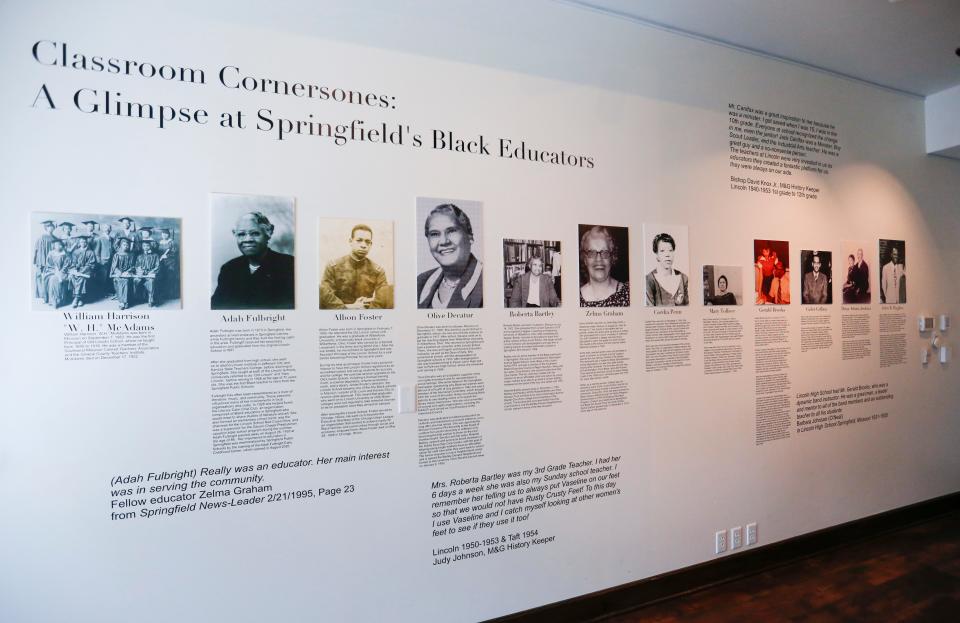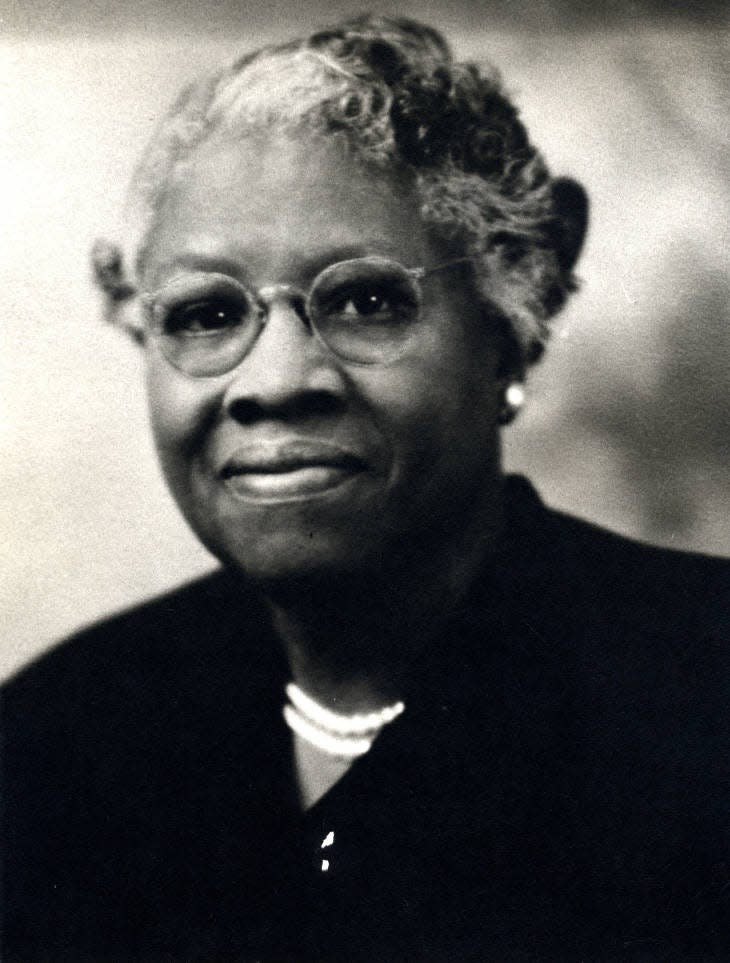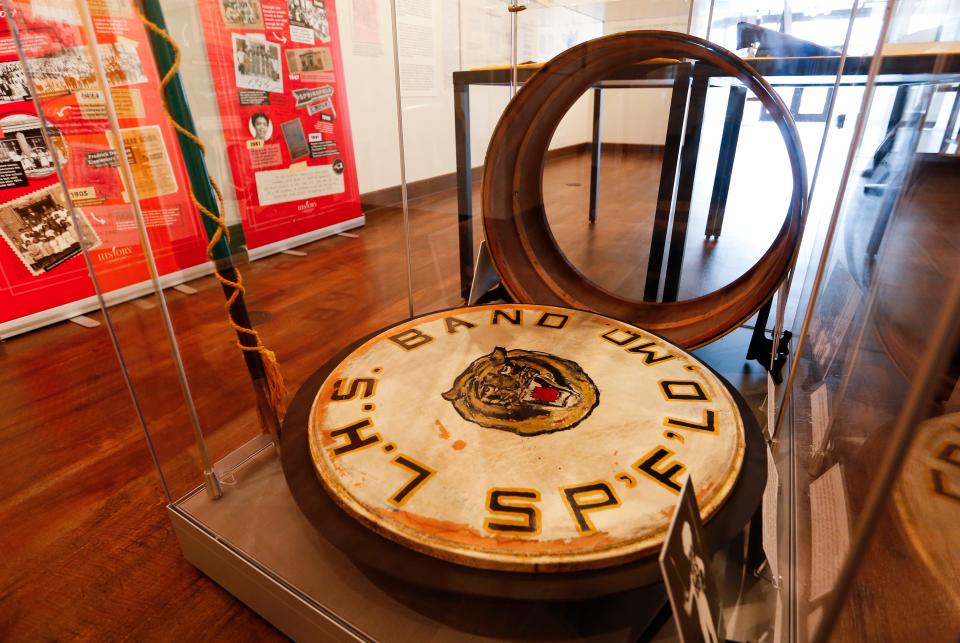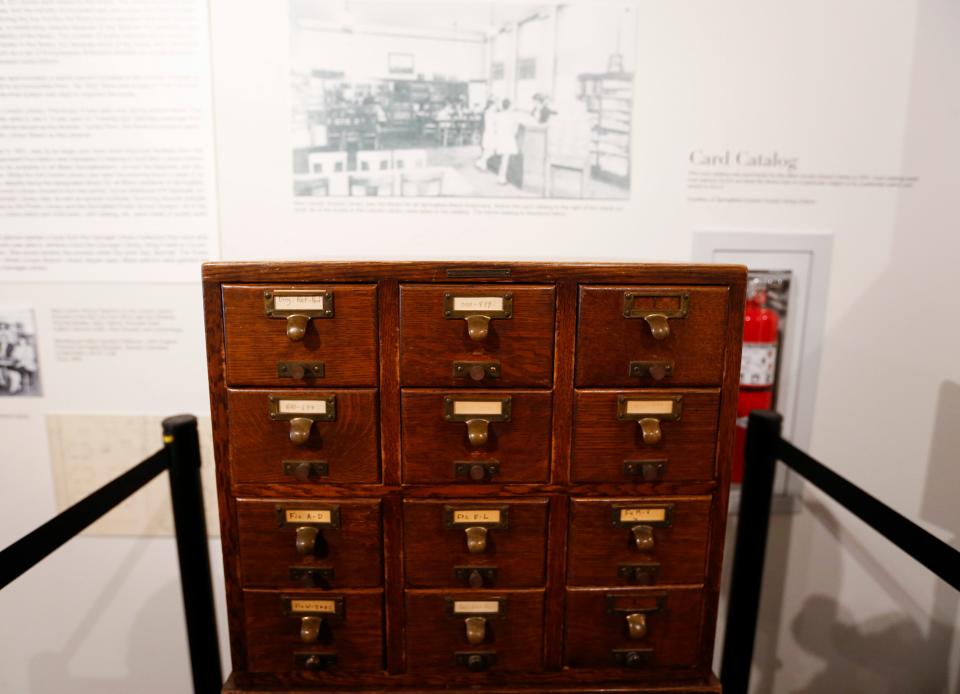Black educators, Lincoln School highlighted in new exhibit at History Museum on the Square
Through the lens of former students, the History Museum on the Square's new special exhibit highlights the history of Springfield's Black education system between the 1800s and early 2000s.
"Community Cornerstones: Springfield's Black Educators" is open through May 7. The exhibit highlights specific Black educators, the Lincoln School and Library, Lincoln Nursery School and Literary Calm Chat Club. On a broader scale, the exhibit also addresses the impacts of desegregation both statewide and nationally.
The Springfield Public School District was established in 1869 with two segregated schools: Central for white children and Lincoln School for Black children. Nearly a century later, in 1954, the U.S. Supreme Court issued its ruling in Brown v. Board of Education, which made segregating students into "separate but equal" schools illegal.
The Springfield Public School board did not wait until federal recommendations on this process were issued in 1955. Rather, only three months after the Supreme Court's ruling, the district began desegregation, according to the museum. Black students for the first time could attend neighborhood schools, junior highs associated with district boundaries and high schools. These students did have the option to remain at Lincoln School, however, for one more year.
More than half of the high school sophomore class at Lincoln School transferred as soon as they were able to, according to the museum.
A 'glimpse' into the history of Springfield's black educators

Several Black former educators are featured in the special exhibit, including individuals who created accessible resources for Springfield's Black community. Among these are William Harrison "W.H." Adams, the first principal at the Old Lincoln School, Adah Fulbright, who helped found the Literary Calm Chat Club in 1928, and Gerald Brooks who helped establish the first band at Lincoln School.

A popular name folks may be familiar with in the exhibit is Zelma Graham, known for operating Graham's Rib Station with her husband James. The Grahams opened the barbeque restaurant in 1932 and operated it for about 60 years, surviving the Great Depression. Although Zelma wasn't a teacher in Springfield, she did help found the first Black Girl Scout troop at Lincoln School.
More:A look back at Graham's Rib Station: 'We were never segregated. We served everyone.'
Several buildings in Springfield bear the name of Black educators who made a difference in the community, including the Bartley-Decatur Neighborhood Center at 918 E. Calhoun St. The building is named after sisters Roberta Bartley and Olive Decatur, who are featured in the exhibit. In the early 1970s, the sisters established Kiddie Kove Day Care in the two-story house on East Calhoun Street because they wanted to continue working with children after retiring as teachers.
The history of the house dates back much further though. Built around 1900, the house held the Springfield Colored Hospital Association and then a Black veteran's home prior to the daycare, according to KSMU.
"People like to research and put exhibits together for really famous people and people, who they feel, made big sweeping gestures and impacts on our community, but the educators in this exhibit worked with people in our community on a day-to-day basis," museum Executive Director Sean FitzGibbons said. "Some educators were even Sunday school teachers, so they had face time with these kids six days a week. The impact they had on our community is huge."
Looking back at two Lincoln Schools
Over the years, there were two Lincoln Schools in Springfield, Old Lincoln School and New Lincoln School. Old Lincoln School operated for about 62 years before New Lincoln School was built in 1930, opening the following year.
New Lincoln School was one of nearly 5,000 schools constructed by the Rosenwald Foundation between 1912-1937 throughout the South for Black children, according to Ozarks Technical Community College. The school closed in 1955 with desegregation.
After its closure, the building reopened as the integrated Eastwood Junior High School and then the Graff Area Vocational-Technical School. Today, the building is home to Lincoln Hall on Ozarks Technical Community College's campus.
Lincoln School was popularly recognized for its marching band. William P. Foster, one of the band's instructors, would go on to found and direct the world-renowned Florida A&M Marching 100.

High school graduation programs and diplomas, yearbooks and prom photos are just a few of the New and Old Lincoln School artifacts the museum's exhibit features. Several Lincoln School marching band items, including a bass drum, drum major hat and baton are also on display.
There was a Lincoln Library, too
During segregation, Black Springfieldians were not allowed to use all the services provided at Springfield's single library, Carnegie Library (now the Midtown Carnegie Branch Library). They were allowed to request circulating books at the front desk and check them out, but they were not allowed to use the library's reading room or access non-circulating books, according to the museum.
In 1917, a small library opened in the Old Lincoln School, containing 465 volumes. The library was supposed to serve only the student body but when it opened, the board agreed that it should be accessible for adults, too, as they had limited access elsewhere. By 1920, the library's inventory increased by 20%, as books were collected from individual donations, purchases and unwanted transfers from Carnegie Library.
Initially, the library was only open during school hours and closed during the summer, but in 1926 this changed. To better accommodate adults, the library, in addition to school hours, was open between 4-5 p.m. on Tuesdays and Saturdays.
When New Lincoln School opened in 1931, so did a new, larger library. There, 476 volumes and several multisets were added to the inventory and hours were extended further. The Lincoln Library remained open after 1947, when Carnegie Library was desegregated and Black Springfieldians were finally able to use all of its services.
Along with a Lincoln School yearbook photo displaying the interior of the Lincoln Library, the museum's exhibit features an original card catalog cabinet, lent by the Springfield-Greene County Library District.

Lincoln Nursery School was supported by church congregations
Separate from the Lincoln School, but still critical to the Black community during segregation, was the Lincoln Nursery School.
Springfield resident Georgia Robinson opened the nursery in May 1946 because her housemaid (whose name is unmentioned in the exhibit and former News-Leader articles) had to give up her job in order to stay home with her own children. The nursery was built at 527 N. Jones Ave., now located under the Martin Luther King Bridge.
Initially, Robinson and a small group of women from the Methodist Women's Society of Christian Service operated the nursery. The city's Community Chest granted the women an initial $1,000 for the project, but their financial pool didn't last long. Eventually, through their women congregations, churches throughout Springfield began to support the nursery, according to Ann Shadburne Gibson's reporting for the News-Leader in 1949.
The same year as Gibson's article, the nursery served an average of 35 children a day. This number grew to 45 children a day in 1952, according to the museum.
The Literary Calm Chat Club left a legacy
Founded in 1928, the Literary Calm Chat Club served as a space for Black educators to discuss art and literature, with an emphasis on Black artists and authors. The club met once a month, sharing their studies through public readings, plays and guest lectures.
"I've heard they were the brain trust of the Lincoln School system," FitzGibbons said.
The Literary Calm Chat Club was dedicated to its community, providing scholarships and awards to students and donating books to the Lincoln Library.
"Community Cornerstones" features several Literary Calm Chat Club artifacts, including its bylaws and meeting minutes, old photos, a corsage from the club's 50th anniversary celebration and an original bookshelf the club used. The bookshelf was commissioned by the Lincoln School shop instructor, according to FitzGibbons. In the exhibit, the bookshelf holds replicas of books that were on the Literary Calm Chat Club and Lincoln Library reading list.
Want to go?
The History Museum on the Square is located at 154 Park Central Square and open Wednesday through Saturday 10 a.m. to 5 p.m. and Sunday 1-5 p.m. Admission is $16 for adults, $13 for seniors, military and students, $10 for children ages 4-12 and free for children under the age of 3. Passes also are available for checkout at Springfield-Greene Library branches. Free two-hour public parking is available at lots located at the corner of Olive Street and Boonville Avenue.
This article originally appeared on Springfield News-Leader: History Museum on the Square highlights Black education in new exhibit

